Diet plays a crucial role in the health of our cats. And as adoptive parents, we want the best for our little protégés. But it's not always easy to read and decipher the labels of cat food and pâté. Because the health and well-being of your little cat are essential, we couldn't leave you in the pâté. We're going to tell you everything so that you can FINALLY make an informed choice!
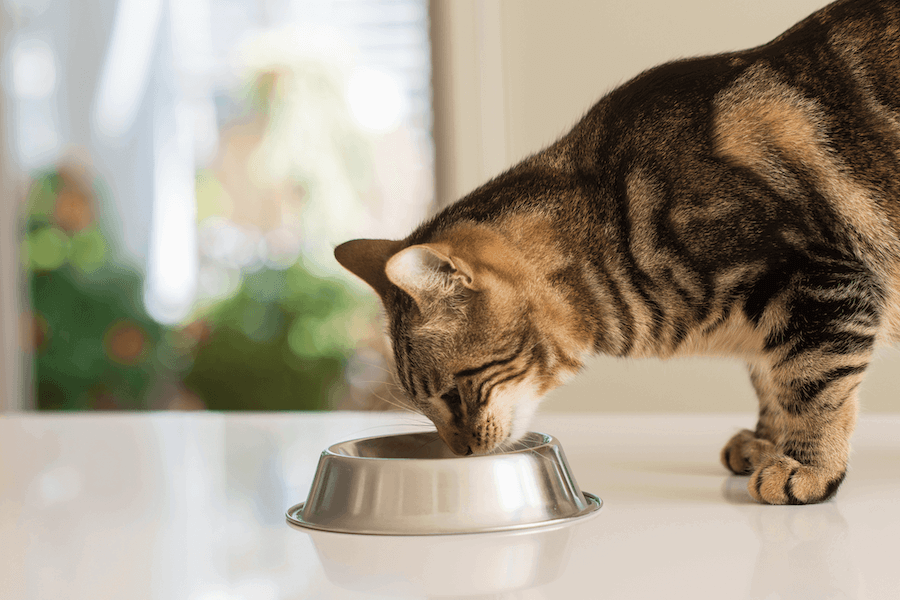
Reading labels on kibble packets: a real headache!
What does my cat eat? More and more of you are asking yourselves this question. And this question is completely legitimate when we know that diet plays an important role in the health of our little balls of fur. Inappropriate and poor quality food is often the cause of many diseases in our whiskered ones: diabetes , cholesterol, obesity , kidney failure . So many pathologies that increasingly affect our cats.
So, faced with concerned parents, many brands are betting on “eating better”. In stores, we see boxes and bags displaying nice labels: “fit for human consumption”, “100% natural”, “rich in fresh meat”, “validated by veterinarians”, etc.
These inscriptions give confidence and therefore encourage the purchase. That said, if the approach is sometimes sincere, we realize for many of them that these are only marketing arguments , often misleading and without any real benefit on our felines.
Another difficulty: the composition. Behind the packages, we find information unknown to many parents, incomprehensible percentages of raw materials.
Because your cat's health is essential, we will teach you here how to read the labels on packets of kibble and pâté so that you can choose the best kibble. and the best pâté for your cat.
Mandatory information on cat food
Bags of kibble and cans of pâté for cats must display mandatory information, including:
- Destination. On packages and boxes intended for cats, manufacturers are required to indicate the animal's life stage: kitten or adult cat. Only these two life stages are regulated by the regulations.
And fortunately so! Food for an adult cat does not contain the same amounts of nutrients as food for a kitten! As it grows, the kitten will need more protein and fat in its diet. It will also need calcium and phosphorus to grow well. Otherwise, it would end up deficient: a calcium deficiency can, for example, lead to bone demineralization, causing frequent fractures and hypocalcemia (compulsive licking of the extremities, digestive disorders, epilepsy).
Find our complete article on the nutritional needs of kittens on our blog.
- Product description : complete or complementary food.
As a reminder, a complete food contains all the nutrients your cat needs to be healthy. It can be given as a sole diet. This means that you do not need to supplement its ration with other foods. Conversely, a complementary food does not cover all of your cat's nutritional needs. It may contain high levels of certain substances or be devoid of certain nutrients. To find out more, do not hesitate to consult our article on complete and complementary pâté .
- The composition (list of ingredients)
- The analytical constituents
It should include the percentage of crude protein, crude fat, crude ash, crude cellulose and moisture.
- Additives
What is it? These are “ substances, micro-organisms or preparations deliberately added to animal feed to fulfil a function. This may be technological (preservatives, gelling agents), sensory (colourings, aromatic substances), nutritional (vitamins, amino acids, trace elements) or zootechnical (aiming to have an effect on the animal; for example the addition of probiotics to improve the balance of the intestinal flora) ”, explains the DGCCRF (General Directorate for Competition, Consumer Affairs and Fraud Control).
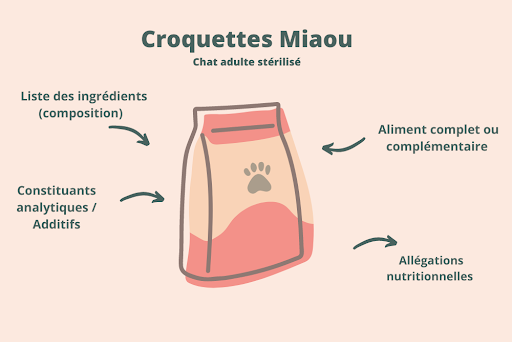
Other information is optional, such as the percentages of calcium, phosphorus, Omega 3 and 6 and the carbohydrate content. If the manufacturer displays them, they must guarantee these contents and indicate these percentages precisely. European regulations require manufacturers to justify all claims made on packaging.
Packet of kibble: packaging is often misleading
Let’s start with the front of the package (kibble or pâté).
Packaging is a marketing tool and many manufacturers rely on it to encourage us to buy their kibble and pâté. On their packages, we find a beautiful photoshopped cat and a whole bunch of information that reassures us and gives us confidence. But be wary, because some images and claims can mislead you.
What’s behind “rich in chicken”
On many boxes and packets, you can read the words “rich in chicken” or “rich in beef”. This is rather reassuring; our little balls of fur being strict carnivores, they need to find animal proteins in their diet to be healthy.
Little important reminder: animal proteins are the source of the 11 essential amino acids for the health of our felines. We find taurine, arginine, phenylalanine, methionine, valine, leucine, isoleucine, lysine, tryptophan, threonine and histidine.
These amino acids are essential for the proper functioning of their body (immunity, growth, digestion, reproduction) and their organism (bones, skin, muscles, hair). Otherwise, our companions would find themselves deficient and would develop very serious health problems such as central retinal degeneration, impaired immune function or even neurological disorders.
Animal proteins are therefore very important and must be present in sufficient quantities.
However, when you choose a bag of kibble or pâté “rich in chicken” for your cat, do not expect to find a majority of chicken in the recipe . Only 14% is enough to obtain authorization to use this mention on the packaging!
According to FEDIAF (The European Pet Food Industry), the following quantities must be present in raw materials that are the subject of a claim:
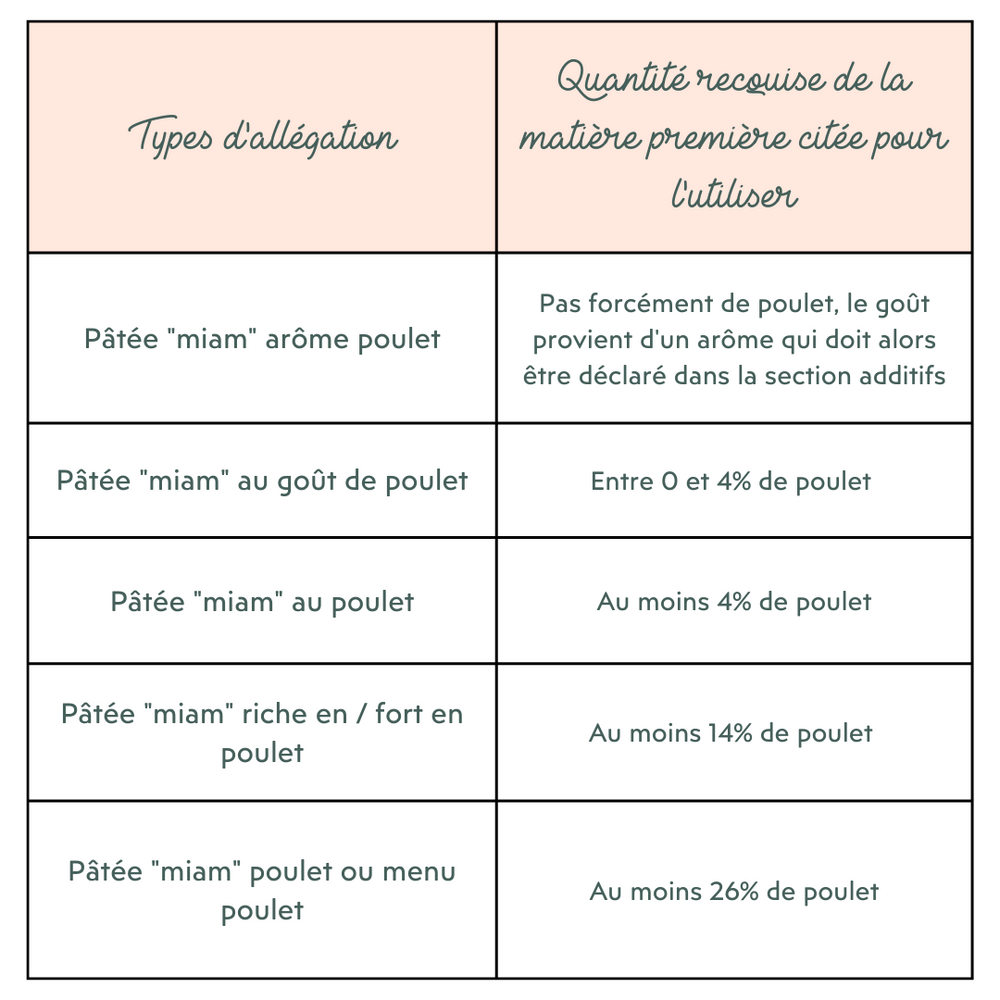
A bit disappointing, right?
For a truly protein-rich meal, choose “Chicken” or “Chicken Menu.”
Don't always rely on protein levels
On cans of pâté and packets of kibble, some manufacturers display a very high level of animal protein, but don't trust them blindly.
In many foods, we do not find noble offal or real pieces of muscle, which have a high nutritional value, but reconstituted meat (mixture of animal and vegetable proteins), animal meal or mechanically separated meat (MSM) .
Animal meal is a “powder obtained by cooking, defatting, sterilizing, grinding and sieving by-products of terrestrial animals”.
What are these “by-products” in cat food ? In pet food, any raw material used, noble or not, is downgraded to “by-products” as soon as it is used for animal feed. An organic chicken fillet in a pâté, for example, is considered a by-product. All food intended for our pets is considered a by-product.
Carcass, bone residue…
As for VSM, it is a product “ obtained by the removal, using mechanical means, of meat, bones or poultry carcasses. Obtained after boning, this product may contain bone, cartilage or marrow residues, unlike minced meat or minced meat ”.
For kibble, the use of VSM is essential, but be aware that there are VSM of varying quality. In high-end kibble, there is more animal protein, while in low-end kibble, there is a high content of bone residue.
These low-quality proteins have very low biological value for your cat. In short, their body does not retain them; they therefore have no nutritional value. The unassimilated amino acids are also eliminated through urine. And the more your cat consumes this type of protein, the more it will strain its kidneys. Which can develop chronic kidney disease in the long term.
Obviously, manufacturers are careful not to specify this VSM.
How do I know if my cat's food contains VSM, carcass?
An indicator that can help you is the ash content (percentage of minerals present). This is one of the analytical constituents , the list of which is on the back of packets of kibble and cans of pâté.
Both the carcass and the bones (if it's a fish product) provide a lot of minerals, including calcium and phosphorus. The higher the level, the more likely it is that the kibble and pâté will contain them.
Another useful indicator: the protein/phosphorus or protein-phosphoric ratio (RPP). In feline nutrition, it is this ratio that allows us to know a little more about the quality of the proteins used during manufacturing.
As explained in our article on proteins in your cat's diet , qualitative protein sources, or those with high biological value such as fish, meat, eggs and offal, have very high ratios (above 35). Poor quality protein sources (or those with low biological value), such as cereals, carcasses and bones, have low protein/phosphorus ratios (below 25).
To determine this ratio, simply divide the crude protein rate by the phosphorus rate.
Good to know! Your cat should not only eat protein. A diet exclusively based on protein is very unbalanced and can lead to deficiencies.
The turkey escalope shown on the packaging does not exist!
Similarly, do not rely on photos or illustrations on packets of kibble and boxes of pâté. Some manufacturers display graphic representations of duck breast or turkey escalope that are clearly intended for human consumption. However, these visuals do not correspond to the reality of the raw materials incorporated into the food.
As mentioned just before, you will find reconstituted meat, animal flour or even VSM. We are a long way from the beautiful escalope presented!
And imagine that it is no different for fish croquettes and pâtés. You probably find more bones and skin than salmon fillet.
The ARPP (Professional Advertising Regulatory Authority) prohibits “ any deception in the graphic or photographic representation of materials of animal origin used in the composition of products, in particular by the insertion (...) of suggestive images that are too flattering in relation to the raw materials actually used ”.
Grain-free kibble, yes, but watch out for carbohydrates!
In recent years, we have seen more and more cat kibbles bearing the words “grain free”, “gluten free” or “grain free”. This has become a selling point for many of us. What could be more normal; our whiskered creatures are not chickens! In the wild, they do not eat wheat or corn, and even less barley. They do ingest it when they devour their prey - cereals are present in their stomachs - but the quantities are really tiny.
Be careful though, “grain-free” does not mean carbohydrate-free!
To make kibble, whether for cats or dogs, you absolutely need starch! Starch is a carbohydrate “ stored by plants in the form of granules which, when crushed, provide a paste ”. It is a kind of glue that allows the kibble to hold together and have an airy and crunchy texture.
Instead of cereals, manufacturers then use other sources of starch such as tapioca or chickpea flour. Substitutes that can increase the carbohydrate content in kitty's food. Some of the legumes used are also very difficult for our cats to digest.
In grain-free kibble and pâtés, keep a close eye on the carbohydrate content. Some products can contain up to 50% carbohydrates, which can be harmful to your little cat in the long term. In particular, it has been suggested that foods rich in carbohydrates could increase the demand for insulin secretion, and thus predispose to the development of diabetes mellitus .
One problem (and not the least): the carbohydrate rate is not always displayed. As mentioned above, manufacturers are not obliged to mention it. If you don't see it, that should alert you. When nothing is mentioned, there is often something to hide...
How to calculate the carbohydrate content in cat kibble and pâté?
The formula is as follows: Add the rates of the analytical constituents (present on the back of the packaging).
Example for a supermarket brand showing 37% crude protein, 13% crude fat, 7% crude ash, 4% crude fiber and 10% moisture.
37 + 13 + 7 + 4 + 10 = 71
Once these rates are added together, subtract the total from 100.
100 - 71 = 29
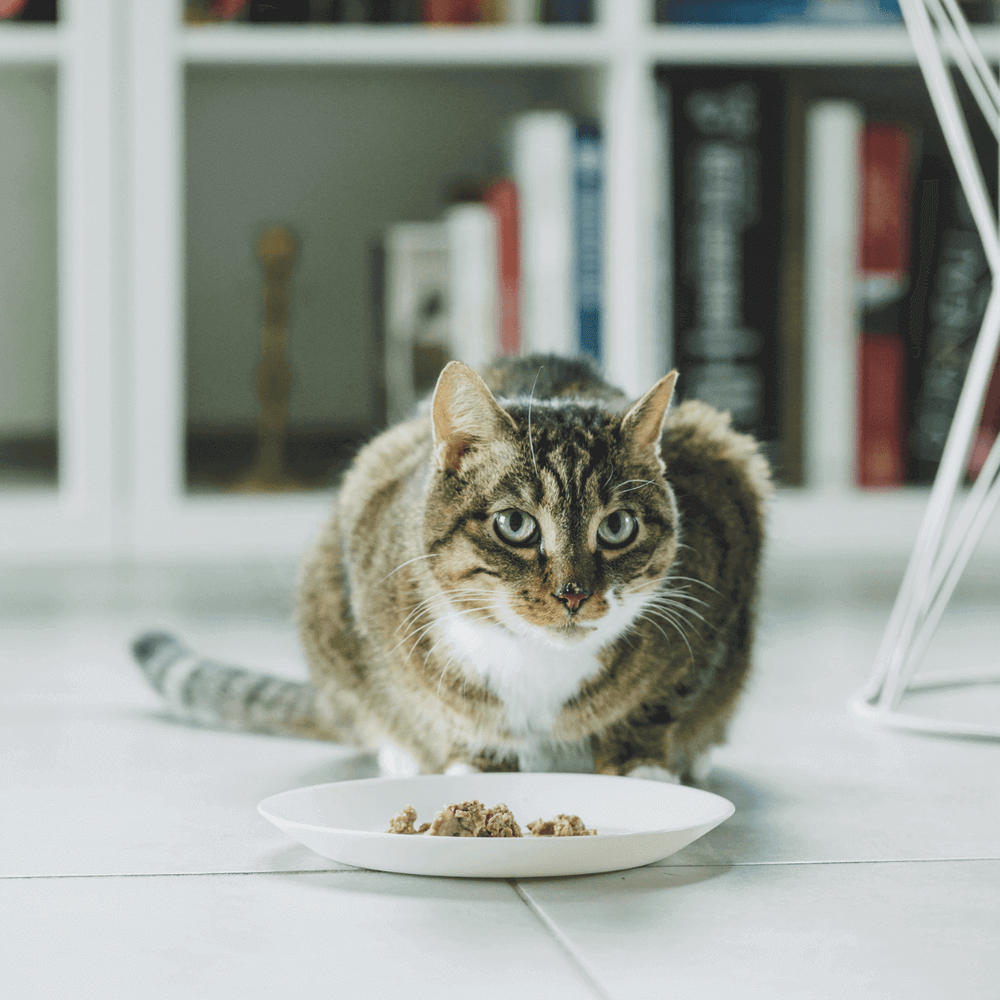
So you have the carbohydrate content of the kibble. This is 29. Which is quite high! Ideally, the content should be zero. But this is impossible, because carbohydrates are naturally found in animal proteins and vegetables. For a kitten, the rate should be 18, and for an adult, 25.
Note that for pâtés, starch is not necessary for their manufacture. But some manufacturers use it. And here again, it will still be advisable to check the carbohydrate content in your kitty's wet food.
At Ziggy, all our pâtés contain less than 2% carbohydrates (naturally present in animal proteins and vegetables). 😺
“Validated by veterinarians”
Some products (sometimes overpriced) display the words “validated by veterinarians”. If the kibble and pâtés are approved by professionals, we can only trust them. Be careful, however, because this promise does not mean much. We do not know who these veterinarians are. It could be anyone. Moreover, no checks have been carried out.
Purebred cat food: lots of marketing
More and more brands also offer kibble adapted to the breed of each cat: Bengal, Maine Coon, British Shorthair, etc. We're not going to lie to you, it's often marketing!
Regardless of breed, all cats have the same nutritional needs.
Of course, some breeds like the Bengal cat have slightly more specific needs. Very athletic, the Bengal cat needs a little more animal protein in its food. However, it does not tolerate starch well due to its recent domestication. The Sphynx, which is hairless, needs more calories in its diet because it burns more energy to maintain its body temperature. As for the Maine Coon , because of its imposing appearance, it also needs a diet rich in protein.
These purebred cats have specific needs, but that doesn't mean you absolutely have to buy suitable kibble!
The only advantage of special Bengal or Maine Coon kibble is the size of the kibble, which is a little more suited to their jaws... This only provides comfort.
Deciphering the composition of cat kibble and pâtés
After the front, let's look at what's behind the packets of kibble and boxes of pâté.
Two things to look at: composition and analytical constituents.
Analytical constituents are the analysis of the nutrients in the finished product. In concrete terms, this is what remains in the final product after cooking. It includes the rates of crude protein, crude fat, crude ash and moisture (for products containing more than 14% moisture).
As for the composition, it is all the ingredients used before manufacturing.
The list of ingredients
All packets of kibble and all cans of pâté must display a list of ingredients. This mandatory display is provided for by EC Regulation 767/2009 of 13 July 2009. European regulations also specify that the ingredients present must be displayed in “ descending order of weight” , i.e. from the heaviest to the lightest.
Concretely, if the first ingredient is wheat, this means that wheat is the most present ingredient in your cat's food. And let's be clear, if this is the case, change your pâté or kibble for your mustachioed one immediately! The first ingredient must be an animal protein.
Want to read more? Download our guide!
Yes, that's right, it's not very nice to stop you in the middle of reading.😾
In our complete guide you will find even more information and advice for choosing the best kibble and pâté for your cat.
Download our complete guide!
In our guide, you will find even more information and advice on choosing the best kibble and pâté for your cat.


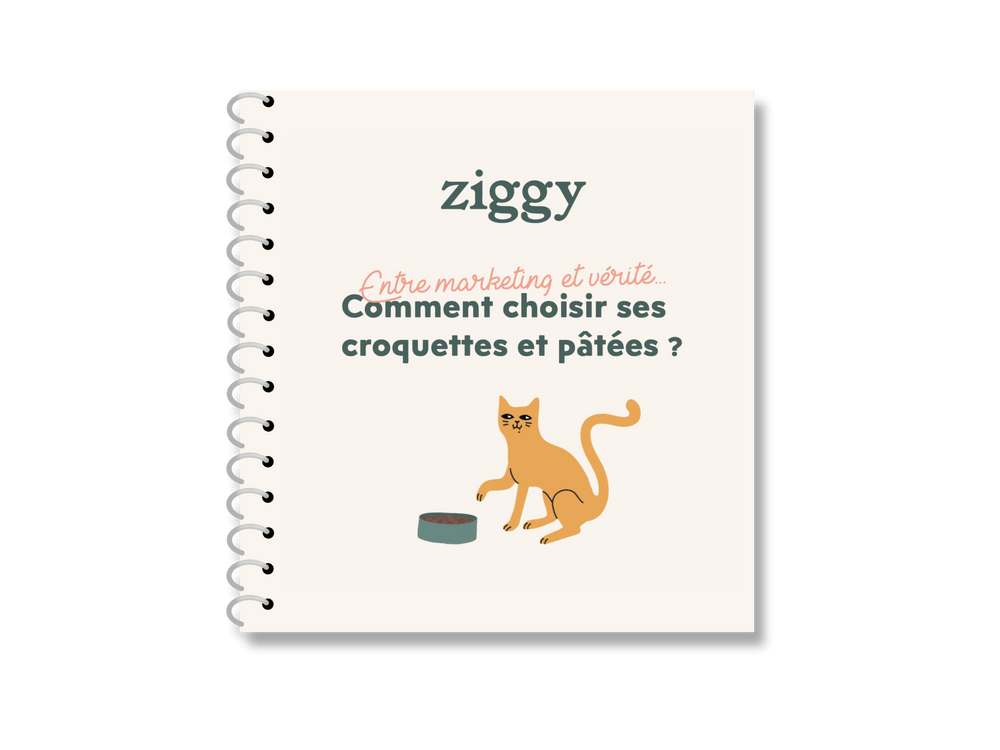
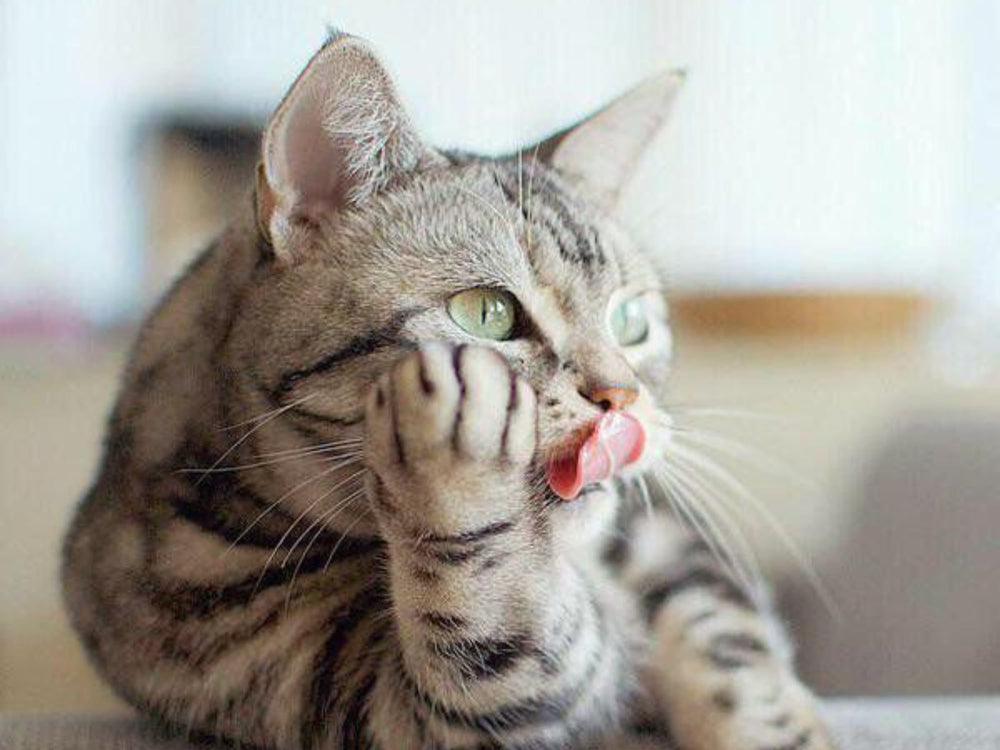
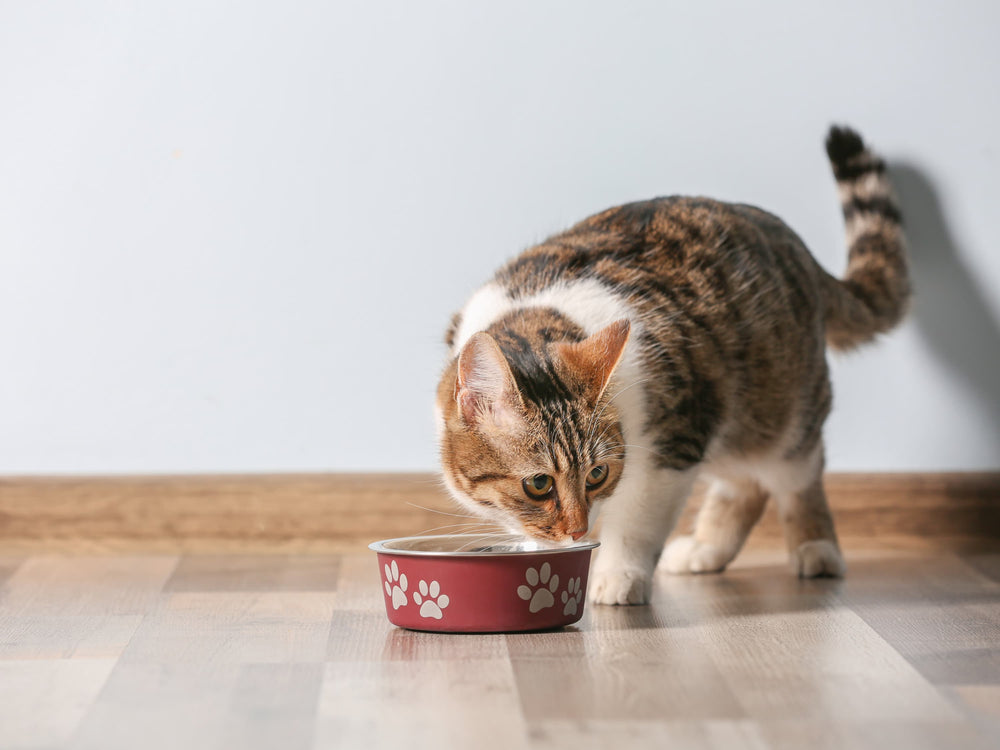
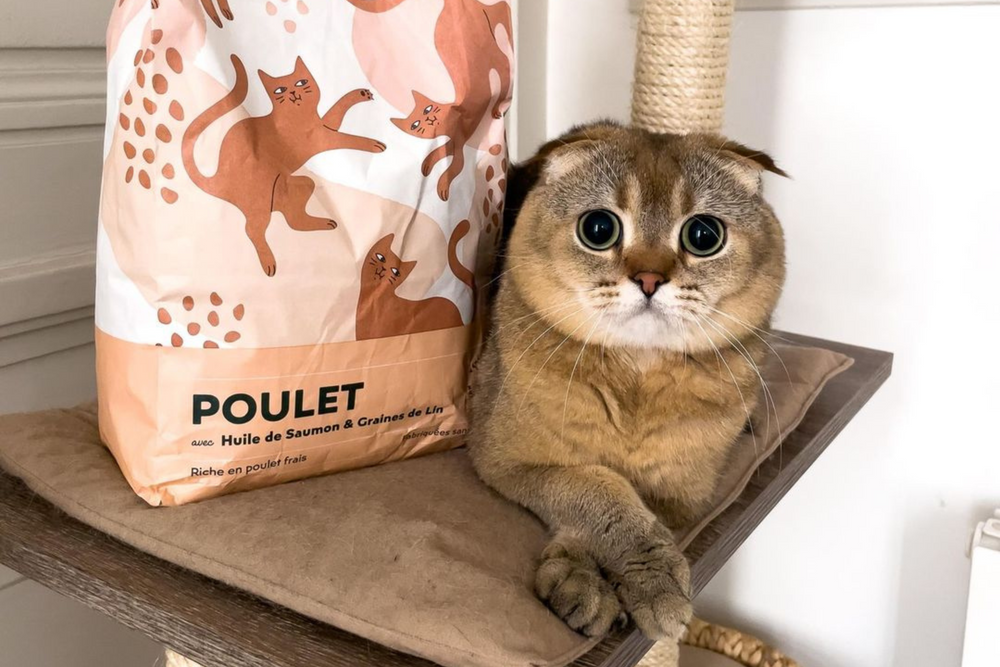
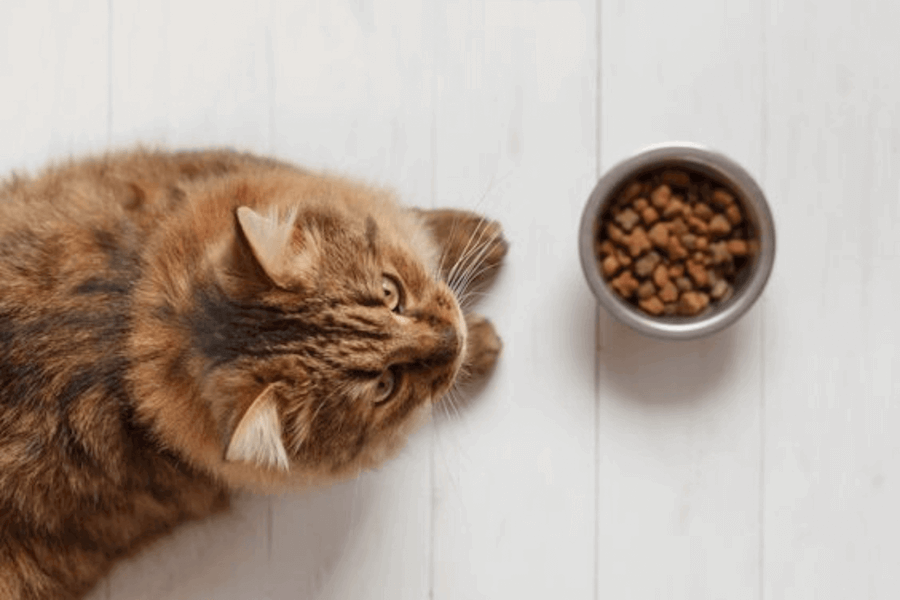
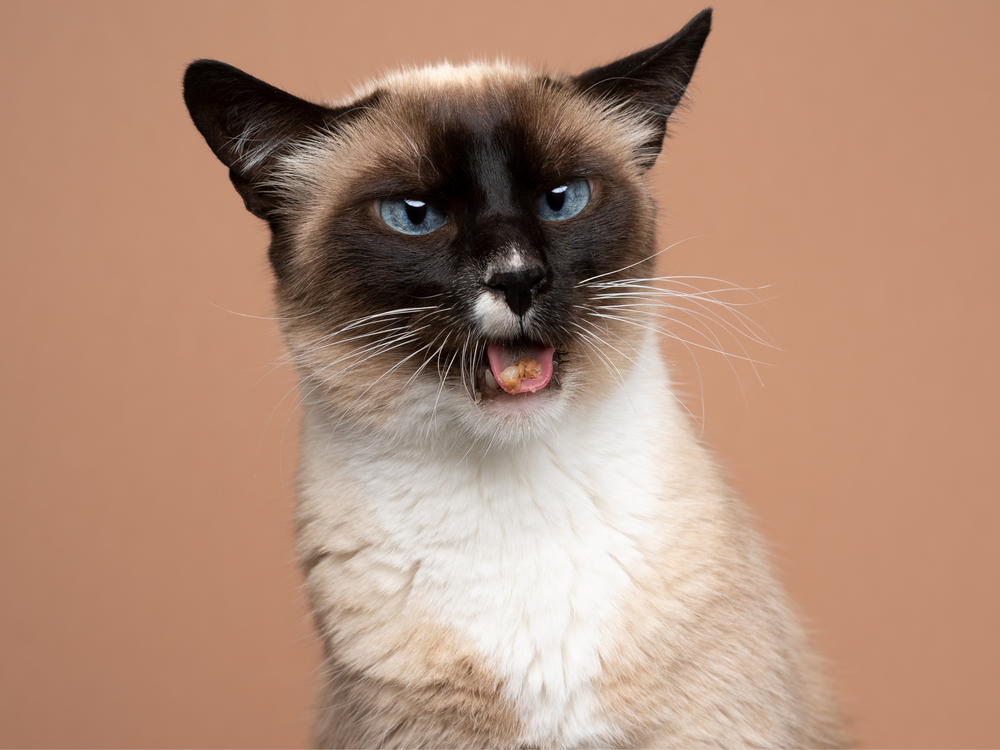



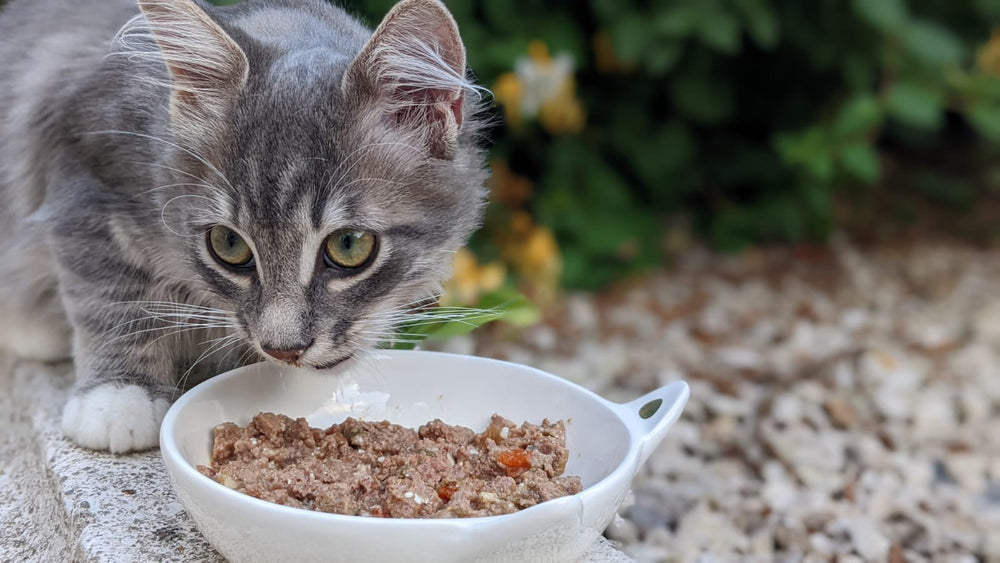
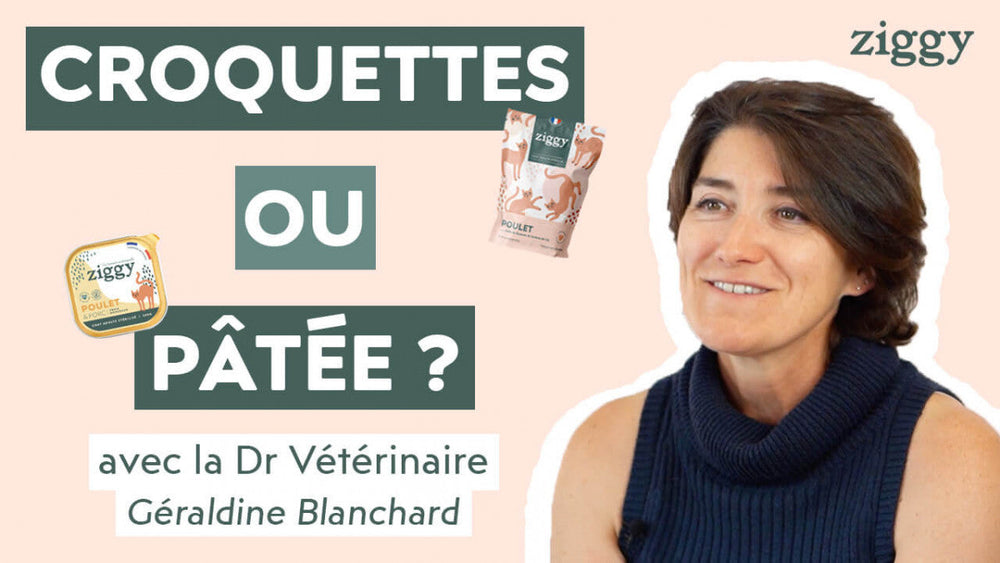
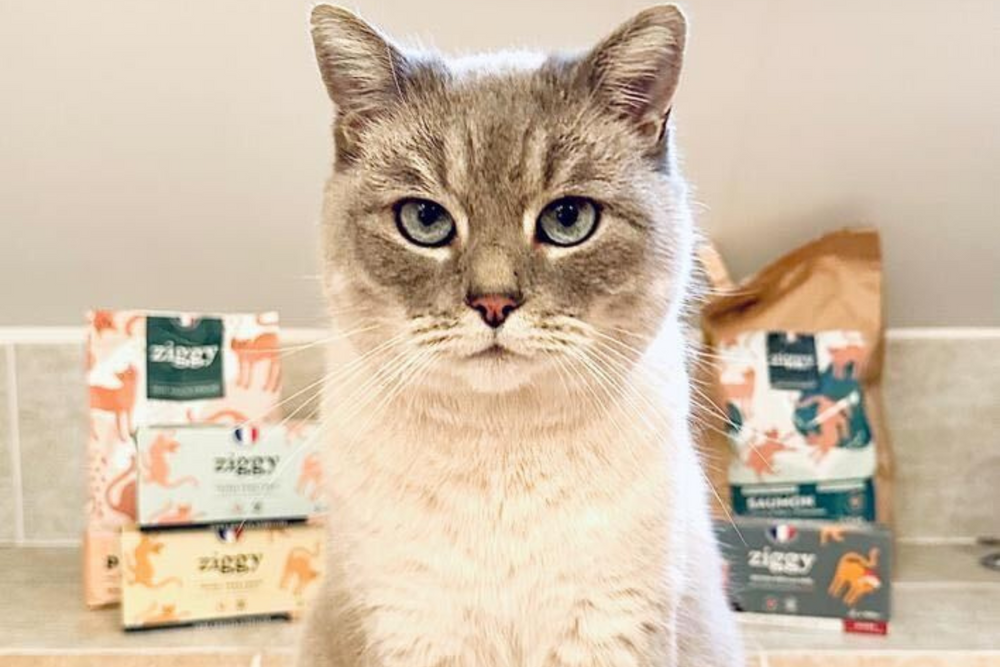


Leave a comment